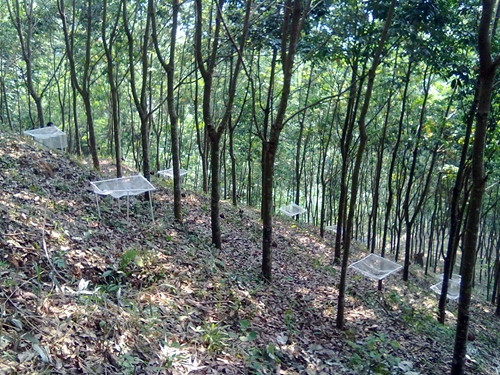During the past decades, large areas of forests have been converted into rubber (Hevea brasiliensis ) plantations in Xishuangbanna, resulting in major alterations in ecosystem carbon (C) dynamics due to deforestation and soil erosion. However, information on the role of various-aged rubber plantations in the C sequestration including its latex C is still lacking.
Researchers from Xishuangbanna Tropical Botanical Garden (XTBG) examined the biomass C accumulation including latex C and C distribution in soil of five different-aged stands (7, 13, 19, 25 and 47 years old) of rubber plantations in Xishuangbanna.
They found that the total biomass carbon stock and total net primary productivity had a close quadratic relationship with stand age. Regardless of stand age, about 68% of the C was stored in aboveground biomass, and latex net primary productivity contributed to approximately 18% of C sequestration.
They found no significant correlation between soil organic C (SOC) stock and stand age, indicating fast organic C turnover in rubber soils. However, SOC stock in the 100 cm depth was age-independent, and decreased with soil depth for each stand.
The total ecosystem C stock (TEC) increased by nearly 82.9% with stand age and would reach maximal value in a 54-year-old stand according to quadratic model including latex C, indicating a considerable C sequestration potential in rubber plantation.
Regression analysis showed that rubber plantations have a potential role in improving the regional C budget in the long term, and thus they can be considered as alternative land use without affecting forest ecosystem C storage.
The researchers suggest that further studies on ecosystem C stock of rubber plantations should include not only potential ecological issues associated with monocultures but also comparisons to mixed agroforestry systems in general.
The study entitled “Carbon Stocks across a Fifty Year Chronosequence of Rubber Plantations in Tropical China” has been published in Forests.
Contact
LIU Chenggang Ph.D
Key Laboratory of Tropical Plant Resources and Sustainable Use, Xishuangbanna Tropical Botanical Garden, Chinese Academy of Sciences, Menglun 666303, Yunnan, China
E-mail: liuchenggang@xtbg.ac.cn

Rubber plantation in Xishuangbanna (Image by LIU Chenggang)

